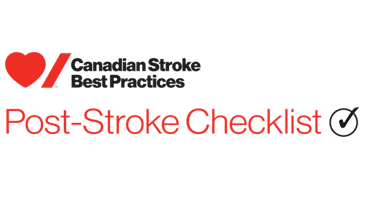- 1. Initial Emergency Management
- 2. Diagnostic Imaging
- 3. Acute Ischemic Stroke Treatment: Intravenous Thrombolysis and Endovascular Treatment
- 4. Management of Acute Hemorrhagic Stroke during Pregnancy (subarachnoid hemorrhage, intracerebral hemorrhage)
- 5. Anesthetic Management in the setting of Acute Stroke during Pregnancy
- 6. Early Post-Stroke Management in a Pregnant Woman
- 7. Post-Stroke Antenatal Obstetric Considerations for Women with a Stroke in Pregnancy
- 8. Intrapartum Considerations
- 9. Post-Partum Management
9.0 Post-Partum Management
- Post-partum pain management should be administered according to local protocols; where possible, avoidance of sedatives is preferred after stroke. In addition, non-steroidal anti-inflammatory drugs (NSAIDs) are avoided in the setting of severe preeclampsia and HELLP syndrome. (SOGC 2014)
- For women who sustain a stroke in pregnancy, long term postpartum follow up arrangements with primary care practitioners should be made including management for secondary prevention of stroke recurrence. [Swartz et al, International Journal of Stroke, 2017].
- Pre-pregnancy counseling should be offered to all women prior to a future pregnancy.
The recommendations from this module have been published in International Journal of Stroke by SAGE Publications Ltd. Copyright © 2017 World Stroke Organization.
Stroke is a leading cause of adult neurological disability, death, and maternal morbidity and mortality in developed nations. Based on the pooled data in a recent meta-analysis (Swartz et al 2017) stroke affects 30/100,000 pregnancies. This is three times higher than rates for young adults overall (10/100,000 per year) and clinical outcomes are dependent on rapid recognition and management. Stroke types are also more varied in pregnancy, with relatively more venous sinus thrombosis and intracranial hemorrhage. In addition, causes more commonly found in young adults (e.g. dissection, congenital cardiac complications), along with physiological adaptations to pregnancy (e.g., hypervolemia, increased clotting factors), and pregnancy specific disorders (e.g., HELLP, preeclampsia) combine to increase risk of stroke in pregnancy. Stroke is sufficiently common that most specialists providing either obstetrical or stroke care encounter women with a past stroke wanting to become pregnant, or women who develop a stroke during or shortly after a pregnancy. Thus, there is a need for a rational approach to management decisions, based on the best available literature, guided by expert consensus.
- Systems in place to enable women who become pregnant or are planning pregnancy to access appropriate antenatal care.
- Collaborative relationships established between obstetrical, maternal-fetal medicine experts and stroke specialists to optimize access and management for women who experience stroke before, during or immediately after pregnancy.
- Protocols to ensure rapid transfer of patients to a centre with acute stroke and obstetrical services available
- Proportion of women with a past history of stroke who experience a recurrent stroke during pregnancy or early postpartum.
- Proportion of women with a past history of stroke who experience a change in neurological abilities (physical, cognitive or functional) during pregnancy or early postpartum (positive or negative).
- Pregnancy-related maternal mortality and morbidity (venous thromboembolism, disability, post-partum hypertension) in women with a past history of stroke.
- Proportions and rates of adverse fetal and neonatal outcomes: congenital anomalies, preterm delivery, perinatal and intrapartum morbidity and mortality.
- Number of women who experience an acute stroke during pregnancy or within 6 weeks post-partum.
- Percentage of strokes occurring per stage of pregnancy
- Gestational age at time of stroke
- Stroke severity
- Number and percentage of women who experience an acute ischemic stroke during pregnancy who are administered intravenous alteplase.
- Number and percentage of women who experience an acute ischemic stroke during pregnancy who undergo acute endovascular thrombectomy.
- Number and percentage of women who experience an acute hemorrhagic stroke during pregnancy who undergo aneurysm clipping or coiling.
- Adjusted mortality percentage and rates for women who experience an acute stroke during pregnancy or within 6 weeks post-partum (stratified by type of stroke, stage of pregnancy, and include all-cause, within 7 days and 30 days of stroke onset).
- Fetal mortality and rates of fetal complications (analyzed separately) in cases where maternal stroke occurs during pregnancy.
- Development of data collection surveillance systems to monitor women who experience stroke prior to, during or immediately after a pregnancy to improve knowledge of safety and efficacy of management approaches, drive quality improvement and systems change.
- Promote randomized controlled trials or large population-based observational studies where feasible to reduce knowledge gaps and increase the ability to move from a consensus statement to an evidence-based clinical practice guideline.
For Professionals
- Acute stroke treatments and vascular risk reduction in non-pregnant women
- Secondary prevention of stroke
- Stroke rehabilitation
- professional.heart.org;
- nice.org.uk
- The Society of Obstetricians and Gynecologists of Canada (SOGC)
- SOGC Hypertensive disorders of pregnancy guideline
- Diabetes Canada Clinical Practice Guidelines
- The American Congress of Obstetricians and Gynecologists
- Diabetes in pregnancy
- General teratogenicity of medications in pregnancy
- Reprotox
- General teratogenicity of medications in breast feeding - Lactmed
- Prescribing medicine in pregnancy
- Mothertobaby.org
For Patients
Acute Tables 9 Post-Partum Management
Initial Emergency Management
While stroke during pregnancy presents several additional challenges, initial emergency investigations and treatment of stroke during pregnancy, or within the 6 weeks thereafter, are similar to treatment in the non-pregnancy state. Rapid presentation to a stroke centre for timely assessment and management and avoidance or any delays in diagnosis and treatments represent the best opportunity for a good outcome for both mother and baby. Hypertension and headaches, which are both common during pregnancy, may also indicate more serious conditions. In particular, rapid identification and treatment of hypertension in a woman presenting with neurological symptoms with a history of preeclampsia is of critical importance, given its strong association with stroke. Crovetto et al. (2013) reported that 33% of women who suffered a stroke had concomitant pre-eclampsia-eclampsia. Hypertensive treatment should be initiated to achieve and maintain a systolic blood pressure of <160 mm Hg (Magee et al. 2014). It should be noted that women with severe preeclampsia and eclampsia do not always present with elevations in diastolic blood pressure (Martin et al. 2005). While common during pregnancy, and often benign, headaches may also occur as the result of more serious neurological conditions. Their history and characteristics should be queried. Thunderclap headache may be a symptom of subarachnoid hemorrhage, while a headache with atypical aura, may result from a stroke or TIA. Headache will accompany ischemic stroke in 17% to 34% of cases and are usually nonspecific in quality, and of moderate intensity. (MacGregor et al. 2014).
Diagnostic Imaging
Many pregnant women and their care providers are concerned about the fetal risk associated with neuroimaging and ionizing radiation. These fears need to be balanced with the potential negative consequences to the mother caused by possible delays in diagnosis of stroke. Therefore, neuroimaging with computed tomography (CT) scan without first confirming a pregnancy is deemed an acceptable practice. In fact, the fetal radiation dose associated with head or neck CT is considered very low (0.001 to 0.01 mGy) (AROC 2017). Most estimates suggest that fetal radiation doses of <50 mGY have negligible risk of fetal malformation, abortions or other pregnancy complications when compared to the general risk of pregnancy (McCollough et al. 2007; Tirada et al. 2015). Magnetic resonance imaging (MRI) is also considered safe at 3.0 tesla or less, (Patenaude et al. 2014) and is not associated with any long-term negative risks. Specifically, no significant increases in neonatal deaths (RR: 1.68; 95% CI: 0.97 to 2.90); congenital abnormalities (HR: 1.16; 95% CI: 0.96 to 1.40); and hearing (HR: 1.50; 95% CI: 0.94 to 2.40) or vision loss (HR: 1.04; 95% CI: 0.75 to 9.6) were documented in a review of over one million births after 20 weeks of gestations in Ontario (Canada) (Ray et al. 2016). However, the use of gadolinium contrast should be avoided unless no alternative exists, or the potential benefits outweigh the risks (ACOG Committee Opinion No. 723, 2017, Patenaude et al. 2014, Thomsen et al. 2013, Brass et al. 2007). Ray et al. (2016) found that compared to no MRI exposure, exposure to gadolinium MRI at any time during pregnancy was associated with an increased risk of a broad set of rheumatological, inflammatory, or infiltrative skin conditions (adjusted HR, 1.36; 95% CI, 1.09 to 1.69). The risk of stillbirth/neonatal death was significantly higher in the gadolinium MRI group (17.6 vs. 6.9/1,000 person-years, adjusted RR=3.70, 95% CI 1.55-8.85).
When diagnostic imaging is required during the post-partum period, less than 1% of contrast dye is excreted into breastmilk, and the dose of iodinated contrast agent in the breastmilk absorbed by infants is 0.5% of the maternal dose (Trembley et al. 2012; ACOG 2017). Thus, the continuation of breastfeeding after exposure to CT contrast does not pose any risk to the infant. However, discarding breastmilk for 24 hours after injection may be recommended to mothers who express concern (Trembley et al. 2012).
Intravenous Thrombolysis and Endovascular Treatment
The use of alteplase is considered a relative exclusion criterion during pregnancy, largely because of the absence of clinical trial data to support its safety for mother and fetus. However, accumulating evidence from case series and case reports suggest there may be an indication for its use during pregnancy in women who would otherwise be eligible for treatment if they were not pregnant. Reports on the pregnancy outcomes of women who received t-PA during the first trimester (Elford et al 2002, Li et al. 2012, Tversky et al. 2016), the second trimester (Wiese et al. 2006, Tassi et al. 2013, Landis et al. 2017), the third trimester of pregnancy (Johnson et al. 2005, Mantoan Ritter et al. 2014, Ritchie et al. 2015) and in the early post-partum period (DeKoninck et al. 2008, Ronning et al. 2010) have been published. Both the intravenous (Wiese at l. 2006, Ritchie et al. 2015, Yversky et al. 2016, Landis et al. 2017) and intra-arterial (Ronning et al. 2010) routes have been used. The initial stroke severity of women who were treated with t-PA in these reports ranged from minor (NIHSS 3, Landis et al. 2017) to moderately-severe (NIHSS 22, Ritchie et al. 2015). Generally, the mother experienced marked improvement or complete recovery following treatment and delivered a healthy baby. The incidence of symptomatic intracerebral hemorrhage (sICH) was low, and comparable to non-pregnant patients. The use of thrombolysis in pregnancy has also been reported in other thromboembolic conditions, such as pulmonary embolism, thrombosis of cardiac valve prosthesis, myocardial infarction, and venous embolism. Overall, the reported complication rates were similar to those of nonpregnant patients; in addition to low rates of maternal mortality, fetal loss, and preterm delivery (Gartman 2013, Leonhardt et al. 2006).
Treatment with thrombolytic agents in the early post-partum period (≤48 hours) is more controversial, given the increased risk of bleeding. Akazawa & Nishida (2017) documented 13 cases where thrombolytics were given to women during this period. The most common indication for treatment was pulmonary embolus, with a single case of ischemic stroke. Blood transfusions were required in all but one case. Subsequent laparotomy to control bleeding was required in five cases, all following cesarean delivery.
To date, there are 4 reported cases of women treated with mechanical thrombectomy during pregnancy, all of which occurred during the third trimester (Bhogal et al. 2017, Aaron et al. 2016). Second-generation devices were used in all cases. The baseline NIHSS scores were ≥15 in 3 cases and could not be assessed in the fourth. The maternal outcomes were good in 3 cases (mRS scores 0-1), with greater residual disability in the fourth case (mRS 2). The pregnancy was ongoing in one published report (Bhogal et al. 2017), while 3 women delivered healthy babies. There were no cases of symptomatic intracerebral hemorrhages (ICH).
Acute Hemorrhagic Stroke Treatment
Pregnancy and the postpartum period are associated with an increased risk of cerebral hemorrhage. Although estimates vary, and reports are limited, the incidence of intracerebral hemorrhage (ICH) per 100,000 pregnancies have been reported to range between 4.6 (Simolke et al. 1991) and 25.4 (Liang et al. 2006). Relative to women who are not pregnant, the risk of ICH appears to be highest after delivery (RR=28.3, 95% CI 13.0–61.4), compared with the risk during pregnancy (RR=2.5, 95% CI 1.0–6.4) (Kittner et al. 1996). The most common risk factors for ICH during pregnancy include increased age, cardiac disease, hypertension, eclampsia/pre-eclampsia and smoking (Bateman et al. 2006). The most common etiologies for ICH include vascular anomalies and AVMs (Liang et al. 2006). While in-hospital mortality for pregnancy-associated ICH has been reported to be as high as 20.3% (Bateman et al. 2006), a more recent report suggests that pregnant women had significantly lower risk in-hospital mortality compared with non-pregnant women (10.1% vs. 19.6%, p=0.002, OR=0.57, 95% CI 0.34-0.94)(Leffert et al. 2015).
There are several factors that may increase the risk of arteriovenous malformations (AVM) or aneurysmal rupture during pregnancy, including increased blood volume and cardiac output, and structural changes in the vascular wall. However, whether pregnancy truly increases the risk of rupture is a topic of ongoing debate. Liu et al. (2014) reported the odds for rupture of AVM during pregnancy and puerperium were significantly lower compared with the control period (OR=0.71, 95% CI 0.61–0.82). The study included 979 women referred to a single teaching hospital between 1960 and 2010 with an AVM confirmed by angiography or histology. A total of 393 patients had an AVM rupture during 16,367 patient-years of follow-up. Similarly, Bateman et al. (2006) reported no significant increased risk of intracranial hemorrhage from cerebrovascular malformations during pregnancy (0.50 vs.0.33 per 100, 000 person-years for pregnant versus nonpregnant patients, respectively). In contrast, Porras et al. (2017) reported a significant increase in the risk of AVM hemorrhage during pregnancy or the puerperium among 191 women with AVM who became pregnant before obliteration. The annual rate of hemorrhage was 5.7% in pregnant women compared with 1.3% in non-pregnant women (RR=4.43, 95% CI 1.98–8.65, p<0.001).
Anesthetic Management for Acute Stroke Treatment during Pregnancy
Women who are pregnant and experience a stroke may require anesthesia associated with procedures related to delivery, the need the emergency neurosurgery, or both. Whether cesarean section or neurosurgical intervention should be prioritized or performed simultaneously is an important issue, as is the decision to use general or spinal and epidural anesthesia when a cesarean section is indicated. In addition to significant maternal physiological changes, the potential for fetal harm should be considered during anesthetic management. The goals of anesthesia should include both fetal and maternal well-being. Where a Caesarean delivery is necessary, the type of anesthesia used should be made in consideration of the mother overall risk to risk. Yoshitani et al. (2013) suggested hyperventilation to reduce intracranial pressure (ICP) should be kept in the range of 25-30 mm Hg since the normal range of PaCO2 during pregnancy decreased to 30-32 mm Hg due to increased ventilation and progesterone. Moreover, excessive deep anesthesia should be avoided to prevent hemodynamic instability. Fluid management; however, has yielded conflicting recommendations, with some studies suggesting that when mannitol is used to control ICP, there is an associated risk of fetal dehydration; while, individual case reports have shown that 0.2 to 0.5mg/kg of mannitol has no significant effect on fetal fluid balance (Yohsitani et al. 2013). Special considerations are required for women with preeclampsia. A review of over 300,000 women who underwent a Caesarean delivery found that general anesthesia for Caesarean delivery was associated with increased risk of stroke when compared to neuraxial anesthesia in preeclamptic women (aHR: 2.38; 95% CI: 1.33 to 4.28) (Huang et al. 2010). Regardless of the preeclamptic status of the mother, maintenance of adequate oxygenation and hemodynamic stability are important for both maternal and fetal safety (Yoshitani et al 2013; Ohno et al. 2013).
Post-Stroke Antenatal Obstetric Considerations for Women with a Stroke in Pregnancy
For a woman who experiences a stroke during pregnancy, the risk of a recurrent event is increased. A prospective cohort study following women after an incident ischemic stroke or TIA in the Netherlands noted the risk of a recurrent vascular events was 35.2% (95% CI: 21.3 to 49.9%) among primi/multiparous women, and 19.6% among nulliparous women during average follow-up of 9.5 years (van Alebeek et al. 2018). Therefore, once the etiology of the stroke is determined, secondary prevention strategies such as antithrombotics and/or antihypertensives should be initiated, as appropriate.
The same approaches to rehabilitation in the non-pregnant condition can be applied to a woman who is pregnant, with modifications as needed. The elements associated with improved functional outcome following a moderately-disabling stroke include adequate intensity of therapy, task-oriented training, and excellent team coordination. Early, intensive rehabilitation has been shown to improve functional recovery. It is important that the rehabilitation therapies be tailored to the tasks that need to be retrained and developed, as well as to the activities of the patient’s choice and to their social roles. The need for a highly-coordinated, specialized team, who meet regularly to discuss the rehabilitation goals and progress, is also vital.
Women who experience a stroke during pregnancy may experience a higher incidence of miscarriage and fetal death. A prospective cohort study following women after an incident ischemic stroke or TIA in the Netherlands noted that compared to women in the general population, miscarriage and fetal death occurred at a significantly higher rate at 35.2% vs. 13.5%, and 6.2% vs. 0.9%, respectively (van Alebeek et al. 2018). Therefore, pregnant women with a history of stroke, or with neurological symptoms consistent with stroke should be managed, and plan to deliver at a facility equipped to treat patients with stroke; where full-time neurosurgeons and/or diagnostic imaging tools suitable for the diagnosis of stroke are readily accessible (Yoshimatsu et al. 2014).
Intrapartum Consideration
While a women’s risk for stroke increases during pregnancy, her odds of a cerebrovascular event following a Caesarean delivery are significantly higher compared to a vaginal delivery. In a review of 1.4 million deliveries across 900 hospitals in the USA, Laska et al. (2000) estimated there were 13.1 cases of peripartum stroke per 100,000 deliveries and 116 cases of peripartum intracranial venous thrombosis (IVT) per 100,000 deliveries. Caesarean delivery was noted to be a significant predictor of stroke (aOR: 3.56; 95% CI: 2.62 to 4.83) in both the peripartum and postpartum period compared to vaginal births. Vaginal delivery may be considered providing in an otherwise uncomplicated case of stroke during pregnancy, provided there is no diagnosis of aneurysm, or there has been no neurosurgical intervention within the week before delivery. However, Caesarean delivery should be considered before neurological intervention, and should be performed before craniotomy after 28 to 32 weeks of gestation as interventions during neurosurgery (e.g. management of hypotension, use of osmotic diuretics, and mechanical hyperventialation) are risks for the fetus (Yoshitani et al. 2013). Regardless of mode of delivery, choice of anesthesia should be made in consultation with other health providers, considering the wishes of the mother. In addition, fetal monitoring should continue according to local guidelines, and to the reassurance of the pregnant patients.
Post-Partum Management
The postpartum period is associated with an increased risk of both ischemic stroke and cerebral hemorrhage (Tate & Bushnell 2011). While the median time of stroke onset post partum has been reported be 8 days (range 3 to 35 days) (Wiltin et al. 2000), the risk appears greatest up to 6 weeks after delivery. Kamel et al. (2014) reported the odds of stroke was highest during the first 6 weeks postpartum compared with the period 6 weeks plus one year postpartum (OR=8.5, 95% CI 4.9-14.8). The risk of stroke is especially increased in the 12- month post-partum period for women with a history of eclampsia-eclampsia (hemorrhagic stroke OR=19.9, 95% CI: 7.75 to 51.11; ischemic stroke OR=4.35, 95% CI 0.58–32.92) (Tang et. al. 2009). Although rare, post-partum stroke carries a mortality rate of 2%-10% (Yoshida et al. 2017, Miller et al. 2016, Leffert et al. 2015). Women with pregnancy-related strokes are less likely to have vascular risk factors such as hyperlipidemia or history of thromboembolism, and more likely to have cerebral venous thromboses (Miller et al. 2016). Nevertheless, secondary stroke prevention strategies should be included during the postpartum period, as appropriate, to reduce the risk of thrombotic complications. Moreover, both clinicians and women should be aware that the risk of blood clots extend beyond the traditional post-partum period of 6 weeks. For high-risk women, extending the recommendation duration of prophylactic anticoagulant therapy may be worth examining. Finally, all women should be educated of the warning signs of potential post-partum stroke, such as difficulty breathing, sudden and severe headaches, or sudden change in consciousness, speech, balance strength or sensation to one side of the body.
The same approaches to rehabilitation in the non-pregnant condition can be applied to a woman who is pregnant, with modifications as needed. The elements associated with improved functional outcome following a moderately-disabling stroke include adequate intensity of therapy, task-oriented training, and excellent team coordination. Early, intensive rehabilitation has been shown to improve functional recovery. It is important that the rehabilitation therapies be tailored to the tasks that need to be retrained and developed, as well as to the activities of the patient’s choice and to their social roles. The need for a highly-coordinated, specialized team, who meet regularly to discuss the rehabilitation goals and progress, is also vital.
Women who experience a stroke during pregnancy may experience a higher incidence of miscarriage and fetal death. A prospective cohort study following women after an incident ischemic stroke or TIA in the Netherlands noted that compared to women in the general population, miscarriage and fetal death occurred at a significantly higher rate at 35.2% vs. 13.5%, and 6.2% vs. 0.9%, respectively (van Alebeek et al. 2018). Therefore, pregnant women with a history of stroke, or with neurological symptoms consistent with stroke should be managed, and plan to deliver at a facility equipped to treat patients with stroke; where full-time neurosurgeons and/or diagnostic imaging tools suitable for the diagnosis of stroke are readily accessible (Yoshimatsu et al. 2014).
Intrapartum Consideration
While a women’s risk for stroke increases during pregnancy, her odds of a cerebrovascular event following a Caesarean delivery are significantly higher compared to a vaginal delivery. In a review of 1.4 million deliveries across 900 hospitals in the USA, Laska et al. (2000) estimated there were 13.1 cases of peripartum stroke per 100,000 deliveries and 116 cases of peripartum intracranial venous thrombosis (IVT) per 100,000 deliveries. Caesarean delivery was noted to be a significant predictor of stroke (aOR: 3.56; 95% CI: 2.62 to 4.83) in both the peripartum and postpartum period compared to vaginal births. Vaginal delivery may be considered providing in an otherwise uncomplicated case of stroke during pregnancy, provided there is no diagnosis of aneurysm, or there has been no neurosurgical intervention within the week before delivery. However, Caesarean delivery should be considered before neurological intervention, and should be performed before craniotomy after 28 to 32 weeks of gestation as interventions during neurosurgery (e.g. management of hypotension, use of osmotic diuretics, and mechanical hyperventialation) are risks for the fetus (Yoshitani et al. 2013). Regardless of mode of delivery, choice of anesthesia should be made in consultation with other health providers, considering the wishes of the mother. In addition, fetal monitoring should continue according to local guidelines, and to the reassurance of the pregnant patients.
Post-Partum Management
The postpartum period is associated with an increased risk of both ischemic stroke and cerebral hemorrhage (Tate & Bushnell 2011). While the median time of stroke onset post partum has been reported be 8 days (range 3 to 35 days) (Wiltin et al. 2000), the risk appears greatest up to 6 weeks after delivery. Kamel et al. (2014) reported the odds of stroke was highest during the first 6 weeks postpartum compared with the period 6 weeks plus one year postpartum (OR=8.5, 95% CI 4.9-14.8). The risk of stroke is especially increased in the 12- month post-partum period for women with a history of eclampsia-eclampsia (hemorrhagic stroke OR=19.9, 95% CI: 7.75 to 51.11; ischemic stroke OR=4.35, 95% CI 0.58–32.92) (Tang et. al. 2009). Although rare, post-partum stroke carries a mortality rate of 2%-10% (Yoshida et al. 2017, Miller et al. 2016, Leffert et al. 2015). Women with pregnancy-related strokes are less likely to have vascular risk factors such as hyperlipidemia or history of thromboembolism, and more likely to have cerebral venous thromboses (Miller et al. 2016). Nevertheless, secondary stroke prevention strategies should be included during the postpartum period, as appropriate, to reduce the risk of thrombotic complications. Moreover, both clinicians and women should be aware that the risk of blood clots extend beyond the traditional post-partum period of 6 weeks. For high-risk women, extending the recommendation duration of prophylactic anticoagulant therapy may be worth examining. Finally, all women should be educated of the warning signs of potential post-partum stroke, such as difficulty breathing, sudden and severe headaches, or sudden change in consciousness, speech, balance strength or sensation to one side of the body.
Akazawa M, Nishida M. Thrombolysis with intravenous recombinant tissue plasminogen activator during early postpartum period: a review of the literature. Acta Obstet Gynecol Scand 2017; 96:529–535.
Gartman E. The use of thrombolytic therapy in pregnancy Obstetric Medicine 2013;6(3): 105–111.
Leffert LR, Clancy CR, Bateman BT, et al. Patient Characteristics and Outcomes After Hemorrhagic Stroke in Pregnancy. Circulation Cardiovascular quality and outcomes. 2015; 8: S170-8.
Leonhardt G, Gaul C, Nietsch HH, Buerke M, Schleussner E. Thrombolytic therapy in pregnancy. J Thromb Thrombolysis. 2006;21:271–276.
MacGreagor AE. MacGregor EA. Headache in pregnancy. CONTINUUM: Lifelong Learning in Neurology. 2014 Feb 1;20(1):128-47.
Magee LA, Pels A, Helewa M, Rey E, von DP. Et al. Diagnosis, evaluation, and management of the hypertensive disorders of pregnancy: executive summary. J Obstet Gynaecol Can 2014;36(5):416-441.
Martin JN Jr, Thigpen BD, Moore RC, Rose CH, Cushman J, May W. Stroke and severe preeclampsia and eclampsia: a paradigm shift focusing on systolic blood pressure. Obstet Gynecol 2005; 105(2): 246-54.
McCollough CH, Schueler BA, Atwell TD, Braun NN, Regner DM, Brown DL, LeRoy AJ. Radiation exposure and pregnancy: when should we be concerned? Radiographics. 2007 Jul;27(4):909-17.
Miller EC, Gatollari HJ, Too G, et al. Risk of Pregnancy-Associated Stroke Across Age Groups in New York State. JAMA neurology. 2016; 73: 1461-7.
Murugappan A, Coplin WM, Al-Sadat AN, McAllen KJ, Schwamm LH, Wechsler LR, Kidwell CS, Saver JL, Starkman S, Gobin YP, Duckwiler G. Thrombolytic therapy of acute ischemic stroke during pregnancy. Neurology 2006;66(5):768-70.
Swartz RH, Cayley ML, Foley N, Ladhani NN, Leffert L, Bushnell C, McClure JA, Lindsay MP. The incidence of pregnancy-related stroke: A systematic review and meta-analysis. International Journal of Stroke. 2017 Oct;12(7):687-97.
Tate J, Bushnell C. Pregnancy and stroke risk in women. Womens Health (Lond Engl). 2011 May; 7(3): 363–374.
Treadwell SD, Thanvi B, Robinson TG. Stroke in Pregnancy and the Puerperium. Postgrad Med J 2008; 84(991): 238-45.
Trembley E, Therasse E, Thomassin N et al. Quality Initiatives Guidelines for use of medical imaging during pregnancy and lactation Radiographics 2012; 32: 897-911. (in published guidelines for section 3.1).
Turrentine MA, Braems G, Ramirez MM. Use of thrombolytics for the treatment of thromboembolic disease during pregnancy. . 1995 Jul 1;50(7):534-41.
Yoshida K, Takahashi JC, Takenobu Y, Suzuki N, Ogawa A and Miyamoto S. Strokes Associated with Pregnancy and Puerperium: A Nationwide Study by the Japan Stroke Society. Stroke. 2017; 48: 276-82.





